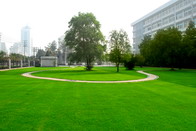Invited by State Key Laboratory of Geodesy and Earth`s Dynamics (SKLGED), associate professor Frederik J Simons of Princeton University visited Institute of Geodesy and Geophysics (IGG) and gave two academic reports “Studying planetary lithospheres using Slepian functions” and “Seismic Tomography with Sparsity Constraints, at the Global and the Exploration Scale” on March 25.
According to Frederik J Simons, all planetary geology is local, so to speak, yet many modern techniques to analyze geophysical signals, from satellite gravity and the geoid, the lithospheric magnetic field, to the making of seismological earth models, heavily rely on a global function basis – the spherical harmonics. When the available data are incomplete and/or noisy, or when the desired models or the features to be extracted are geographically localized (geomorphological structures, magnetic anomalies, earthquakes, etc.), these have easily demonstrable shortcomings. Enter Slepian functions: firmly rooted in the theory of potential fields, they are designed to combine the best of both the spatial and spectral viewpoints by achieving optimal spatio-spectral localization. A basis of Slepian functions for geophysical signals is sparse, and when used as windows to taper data for spectral analysis, they allow for the robust extraction of localized power. Among the applications are the analysis of the time-variable gravity field for the recovery of the signal of melting ice caps in Greenland and Antarctica or of coseismic gravity perturbations, the localization of geologically relevant and coherent areas on the surface of Venus, the analysis of the Martian magnetic field for the signature of its crustal source depth and intensities, of the terrestrial magnetic field for the separation of the signature of oceanic and continental magnetic anomalies, the recovery of the power spectral density of the cosmic microwave background radiation, and the filtering of the geoid for geodynamic applications, and more.
After the report, Frederik J Simons had a deep discussion with the audiences.

Frederik J Simons giving the report in IGG

